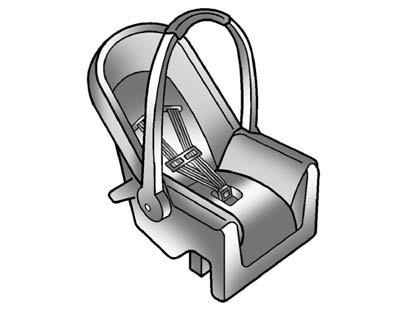Child Restraint Systems
 " width=409 height=331
id="_x0000_i1238" src="images/books/1183/2/index.81.gif" border=0>
" width=409 height=331
id="_x0000_i1238" src="images/books/1183/2/index.81.gif" border=0>
(A) Rear-Facing Infant Seat
A rear-facing infant seat (A) provides restraint with the seating surface against the back of the infant.
The harness system holds the infant in place and, in a crash, acts to keep the infant positioned in the restraint.
 " width=409 height=331
id="_x0000_i1239" src="images/books/1183/2/index.82.gif" border=0>
" width=409 height=331
id="_x0000_i1239" src="images/books/1183/2/index.82.gif" border=0>
(B) Forward-Facing Child Sea
A forward-facing child seat (B) provides restraint for the child's body with the harness.
 " width=409 height=331
id="_x0000_i1240" src="images/books/1183/2/index.83.gif" border=0>
" width=409 height=331
id="_x0000_i1240" src="images/books/1183/2/index.83.gif" border=0>
(C) Booster Seats
A booster seat (C) is a child restraint designed to improve the fit of the vehicle's safety belt system.
A booster seat can also help a child to see out the window.
See also:
Wheel Replacement
Replace any wheel that is bent,
cracked, or badly rusted or
corroded. If wheel nuts keep coming
loose, the wheel, wheel bolts, and
wheel nuts should be replaced.
If the wheel leaks air, repla ...
No Folder
When the CD contains only compressed files, the files are located under the root
folder. The next and previous folder functions will have no function on a CD that
was recorded without folders or p ...
Care of the CD/DVD Player
Do not add a label to a disc; it could
get caught in the CD/DVD player.
If a label is needed, label the
top of the recorded disc with a
marking pen.
The use of disc lens cleaners for
discs i ...






